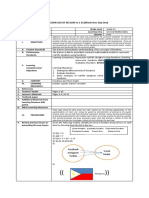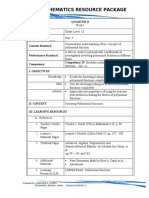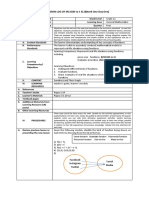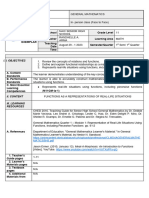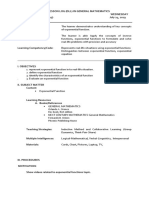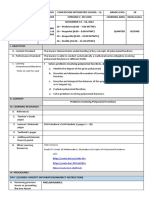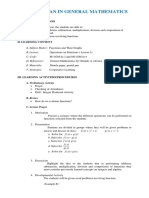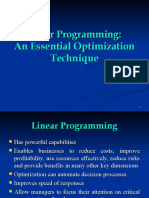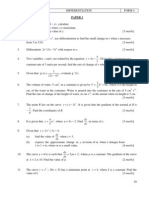Week1 Q1
Week1 Q1
Uploaded by
Miss DianaCopyright:
Available Formats
Week1 Q1
Week1 Q1
Uploaded by
Miss DianaOriginal Title
Copyright
Available Formats
Share this document
Did you find this document useful?
Is this content inappropriate?
Copyright:
Available Formats
Week1 Q1
Week1 Q1
Uploaded by
Miss DianaCopyright:
Available Formats
MATHEMATICS LESSON PLAN
GRADE LEVEL QUARTER / COMPONENT DATE SECTION
11 1st / General Mathematics August 1-2, AFA, HUMSS C & D, IA E &
2024 F, HE A
I. OBJECTIVES
Represents real-life situations using functions, including piece-wise functions.
A. Learning
(M11GM-Ia-1)
Competencies
Evaluates a function. (M11GM-Ia-2)
B. Objectives At the end a 60-minute class session, the Grade-11 students must be able to:
a. Distinguish different kinds of functions
b. Evaluate functions.
c. Share examples of real-life situations which can be represented using functions.
II. SUBJECT MATTER Functions and Their Graphs
MAJOR CONCEPT
1. Learner’s Module Grade -11 General Mathematics Module 1 week 1
2. Other Learning
Laptop, audio-visual presentation, power point
Resources/Materials
3. Strategies Differentiated Learning, Socratic Questioning, Self-Exploration
III. PROCEDURES
Greetings
A. DAILY ROUTINE Prayer
Given the following models, identify the kind of function being shown on each item by choosing from
the list in the box.
Linear function Quadratic function Polynomial Function
Piecewise Function One-to-One Many-to-One
1) f(x) = 7x
2) g(x) = x2
3) h(x) = x3 + 2x2 – x +1
4) {(1,2), (2,4),(3,9)}
5)
Facebook
Instagram Social
Twitter Media
B. DRILL AND REVIEW 6)
6) {( , Philippines )} , Philippines )}
7)
8)
{8 ,1<x≤5¿¿¿¿
C. LESSON PROPER:
The teacher lets the students realize that being able to model real-life situations will help us
I DO understand better the concept of functions including piece-wise functions.
(Contextualization & Localization)
The teacher divides the class into groups with five members, do a 2 – part Activity.
First part, requires each group to come up with 2 real –life examples of functions
modelled by a mapping diagram and set of ordered pairs.
Second part, asks the group to choose which best represents a real-life situation: A
jeepney passenger pays P8.00 for the first 5 km as fare and an additional
P1.00 for every succeeding distance x in kilometer.
A. f(x) =
{8 ,1<x≤5¿¿¿¿ B. f(x) = 8 +1.00x
The teacher discusses with the students why the real-life examples they give illustrate
functions and of why they have chosen such representation for part 2 in the activity.
The teacher explains that Choice A in the second part of the activity is a representation of a
piece-wise function. Explain further that Piece-wise function is used whenever it is not
possible to represent a situation with just one equation.
Given a function f(x) = 2x, what is the result when you replace x by 2 in the function? If x =
0? If x = -1?
Tell to the class that the one done is evaluating functions.
Steps to undertake in evaluating functions are
1) Substitute the value to the variable.
2) Do the operation to find the value of the function.
WE DO
Ask students of real-life situations which can be represented by a piece-wise function.
(Contextualization & Localization)
Possible Answers: Internet payment; Taxi fare
Secondly, ask them to think of situations where evaluation of functions can be applied.
Example answers: when computing for salary; when computing for fare; when purchasing
items
Activity: Evaluate the following functions.
1) f(x) = 3x ; if x = 4
YOU DO 2) f(x) = x/2, if x = 0
3) f(x) = 2x3 – 8, if x = -3
4)f(x) = x - 3 , if x = 12
A. 1) Which best represents the situation below.
The sweet corn sold in the canteen is at P7.00. If I want to buy x pieces of sweet corn, how
much will I pay?
A. f(x) = 7 + x B. f(x) = 7x c.) f(x)= 7
2) Represent the situation in any possible model.
EVALUATION With Santos family, mama and the eldest child are both of blood type A, papa, youngest and
the middle child are all blood type B.
B. Evaluate the following:
1) h(x) = x3 – x2 +x – 2, if x = 0 2) g(x) = (x + 4)(x – 1) , if x = -2
3) f(x) = 1/x, if x = 3 4) h(x) = 4x – 2, if x = 1
5) f(x) = 5(x+2) , if x = 4
AGREEMENT
Reflect on your teaching and assess yourself as a teacher. Think about your students’ progress. What works? What else needs
REFLECTION to be done to help the pupils/students learn? Identify what help your instructional supervisors can provide for you so when you
meet them, you can ask them relevant questions.
Prepared by:
DIANA MAE D. NAVEA-HAIBER
SST - I
Raters:
NURHASSAN TANGKAAN JEBRATAL SALIHON
Mathematics Coordinator Master Teacher I
Date: _________________ Date: __________________
You might also like
- DAILY LESSON LOG OF M11GM-Ia-1 & 2 (Week One-Day One) : Facebook Instagram Twitter Social MediaDocument4 pagesDAILY LESSON LOG OF M11GM-Ia-1 & 2 (Week One-Day One) : Facebook Instagram Twitter Social MediaGladzangel Loricabv50% (4)
- Demo (Inverse of One-to-One Functions)Document3 pagesDemo (Inverse of One-to-One Functions)April Joy LascuñaNo ratings yet
- G10 DLP Q2 Week 1 Day 3Document11 pagesG10 DLP Q2 Week 1 Day 3Kenneth Carl E. KadusaleNo ratings yet
- Marco ManettiDocument315 pagesMarco ManettiPranshu Gupta100% (2)
- DAILY LESSON LOG OF M11GM-Ia-1 & 2 (Week One-Day One) : Facebook Instagram Twitter Social MediaDocument4 pagesDAILY LESSON LOG OF M11GM-Ia-1 & 2 (Week One-Day One) : Facebook Instagram Twitter Social MediaAmanie Usman Amanoddin100% (2)
- Relation and FunctionDocument4 pagesRelation and Functiongerome tapereNo ratings yet
- DAILY LESSON LOG OF M11GM-Ia-1 & 2 (Week One-Day One) : Facebook Instagram Twitter Social MediaDocument4 pagesDAILY LESSON LOG OF M11GM-Ia-1 & 2 (Week One-Day One) : Facebook Instagram Twitter Social MediaLoreen RoaNo ratings yet
- MATH G11 GM I Day 1Document3 pagesMATH G11 GM I Day 1AJ Diawara CusayNo ratings yet
- Gen Math - Lesson1&2Document5 pagesGen Math - Lesson1&2Gladzangel LoricabvNo ratings yet
- GM I - 1(1)Document3 pagesGM I - 1(1)Kit Middleton LouisNo ratings yet
- GENMATH-DLP-Q1-Week-1-SESSION 1Document9 pagesGENMATH-DLP-Q1-Week-1-SESSION 1randhelle.armaNo ratings yet
- Week 3 Day 1 (L7.subtask 2)Document5 pagesWeek 3 Day 1 (L7.subtask 2)Dindin Oromedlav LoricaNo ratings yet
- Daily Lesson Log: TeacherDocument5 pagesDaily Lesson Log: TeacherJoan Ramirez RongaleriosNo ratings yet
- Weekly Prototype Plan Week 2 General MathematicsDocument7 pagesWeekly Prototype Plan Week 2 General MathematicsLily Anne Ramos MendozaNo ratings yet
- Week 4 Day 1 (Lesson 9)Document4 pagesWeek 4 Day 1 (Lesson 9)PatzAlzateParaguya100% (1)
- SHS Lesson PlanDocument6 pagesSHS Lesson PlanNiño Lemuel Lazatin Concina100% (2)
- DLP in General Mathematics- GM-Ia-2-july 2021Document1 pageDLP in General Mathematics- GM-Ia-2-july 2021RODULFO V. PAQUINGANNo ratings yet
- Week 4 day 1(Lesson 9)Document4 pagesWeek 4 day 1(Lesson 9)Therese June Cabilin BuñaoNo ratings yet
- Worksheet in General Mathematics 11: Villaba National Comprehensive High SchoolDocument2 pagesWorksheet in General Mathematics 11: Villaba National Comprehensive High SchoolJOSEPHINE SANCHEZNo ratings yet
- Week 1. Day 2 (Lesson 2)Document6 pagesWeek 1. Day 2 (Lesson 2)Gladzangel LoricabvNo ratings yet
- G10 DLP Q2 Week 1 Day 3Document11 pagesG10 DLP Q2 Week 1 Day 3Lourdes de Jesus100% (1)
- Genmath 11 (Determining X & y Intercepts) - Lesson PlanDocument5 pagesGenmath 11 (Determining X & y Intercepts) - Lesson Planjonathan ian ubasNo ratings yet
- LS3 GenMath 1st QTR Week2 Day1Document6 pagesLS3 GenMath 1st QTR Week2 Day1felina.ting1975No ratings yet
- A Lesson Plan in General MathematicsDocument2 pagesA Lesson Plan in General Mathematicsgrace jane ButacNo ratings yet
- Lesson Plan 1STDocument5 pagesLesson Plan 1STApril TubaNo ratings yet
- DLL Ko PDFDocument2 pagesDLL Ko PDFBryan Christofer SarazaNo ratings yet
- DLL Gen Math Week 2Document8 pagesDLL Gen Math Week 2Ram GazerNo ratings yet
- Monday Tuesday Wednesday Thursday FridayDocument7 pagesMonday Tuesday Wednesday Thursday FridayJESPHER GARCIANo ratings yet
- M11GM Ib 1Document5 pagesM11GM Ib 1Joan Antonio100% (1)
- DLP DemoDocument5 pagesDLP DemoarlenejoyNo ratings yet
- M11GM Ie 4Document3 pagesM11GM Ie 4Joan AntonioNo ratings yet
- I-Day 30Document3 pagesI-Day 30EDITHA PAGUYONo ratings yet
- Lesson Plan in Gen - MathDocument6 pagesLesson Plan in Gen - MathMary June P. PanizalesNo ratings yet
- General Mathematics 1st Periodic ExamDocument3 pagesGeneral Mathematics 1st Periodic Examreden.oriolaNo ratings yet
- LP For Disabilities, Giftedness, TalentedDocument11 pagesLP For Disabilities, Giftedness, TalentedAlma Mae PutongNo ratings yet
- DLP ElsDocument4 pagesDLP Elsjamia mangotaraNo ratings yet
- DAILY LESSON LOG OF M11GM-Ig-1 (Week Seven-Day One)Document4 pagesDAILY LESSON LOG OF M11GM-Ig-1 (Week Seven-Day One)Marisa NiezNo ratings yet
- Week 1. Day 1 (Lesson1)Document9 pagesWeek 1. Day 1 (Lesson1)John Mark PalmaNo ratings yet
- DLL TTTTTTDocument7 pagesDLL TTTTTTAbegail PanangNo ratings yet
- q1 LP in Math 9-1Document7 pagesq1 LP in Math 9-1Charmaine VillamonteNo ratings yet
- Q2 - DLL-De Leon - November 07 - 11, 2022 - 2Document7 pagesQ2 - DLL-De Leon - November 07 - 11, 2022 - 2Cipriano De LeonNo ratings yet
- Mathematics Essential Learning Competencies Teaching-Learning Resources General Mathematics (Grade 11)Document28 pagesMathematics Essential Learning Competencies Teaching-Learning Resources General Mathematics (Grade 11)Monalisa Garcia BasañesNo ratings yet
- Genmath Function Introduction - Lesson PlanDocument5 pagesGenmath Function Introduction - Lesson Planjonathan ian ubasNo ratings yet
- Composite FunctionDocument2 pagesComposite FunctionDerren Nierras GayloNo ratings yet
- Week 3 Day 1 (L7.Subtask 2)Document5 pagesWeek 3 Day 1 (L7.Subtask 2)John Mark PalmaNo ratings yet
- July 2 - 5 - Eval FunctinsDocument4 pagesJuly 2 - 5 - Eval FunctinsMark Alconaba GeronimoNo ratings yet
- CO 2024 LS G11 CUF GenMath R W1 - RTPDocument11 pagesCO 2024 LS G11 CUF GenMath R W1 - RTPjocelmay.galvezNo ratings yet
- DLP December 5, 2022Document3 pagesDLP December 5, 2022John leo ClausNo ratings yet
- Q1W1D2Document5 pagesQ1W1D2Angela RuleteNo ratings yet
- General Mathematics Week 1Document3 pagesGeneral Mathematics Week 1Aron AdarsonNo ratings yet
- Week 4Document2 pagesWeek 4Teofilo CunananNo ratings yet
- Weekly Prototype Plan Week 3 General MathematicsDocument5 pagesWeekly Prototype Plan Week 3 General MathematicsLily Anne Ramos MendozaNo ratings yet
- LP Genmath July 29-Aug 2Document3 pagesLP Genmath July 29-Aug 2Anna Chriscelthia TanyagNo ratings yet
- Q2 - DLL-De Leon - November 14 - 18, 2022Document6 pagesQ2 - DLL-De Leon - November 14 - 18, 2022Cipriano De LeonNo ratings yet
- M11GM I A 3 BDocument2 pagesM11GM I A 3 BGemark D. Gebone67% (3)
- Gen Math Lesson 2Document2 pagesGen Math Lesson 2Derren Nierras Gaylo100% (20)
- One-To-One FunctionsDocument2 pagesOne-To-One FunctionsDominic Dalton Caling100% (1)
- Week 1. Day 1 (Lesson1)Document9 pagesWeek 1. Day 1 (Lesson1)PatzAlzateParaguyaNo ratings yet
- Q1 W1 D1 Factoring Polynomials Common Monomial FactorDocument7 pagesQ1 W1 D1 Factoring Polynomials Common Monomial FactorCristopher MusicoNo ratings yet
- Hájek Projection and U-StatisticsDocument8 pagesHájek Projection and U-Statisticsdimib57465No ratings yet
- Real Analysis: Jos e Mar Ia CuetoDocument14 pagesReal Analysis: Jos e Mar Ia CuetoFor ThingsNo ratings yet
- Transshipment Problem: Presented By: Shreeya Sharma Roll No: 21154 Hospital ManagementDocument16 pagesTransshipment Problem: Presented By: Shreeya Sharma Roll No: 21154 Hospital ManagementShreeya SharmaNo ratings yet
- You Will Work Fewer Than 25 Hours This WeekDocument5 pagesYou Will Work Fewer Than 25 Hours This WeekRyan MartinezNo ratings yet
- PDE Weak SolutionsDocument20 pagesPDE Weak SolutionsLucasMartinsRochaNo ratings yet
- MATHEMATICS 10 First Quarter ReviewerDocument6 pagesMATHEMATICS 10 First Quarter ReviewerMaljur fraden Y. DizonNo ratings yet
- MTC-233 Python Programing Language I Slips Semester IIIDocument50 pagesMTC-233 Python Programing Language I Slips Semester IIIuaena984No ratings yet
- Thermodynamics With Internal State Variables - Coleman - Gurtin - 1967Document18 pagesThermodynamics With Internal State Variables - Coleman - Gurtin - 1967Nidhal JridiNo ratings yet
- ECE 534 Information Theory - MIDTERMDocument10 pagesECE 534 Information Theory - MIDTERMEslam SaeedNo ratings yet
- Linear Programming: An Essential Optimization TechniqueDocument43 pagesLinear Programming: An Essential Optimization TechniqueALLISON GRUBBSNo ratings yet
- Spectral Measures and The Spectral Theorem: 1 Preliminary Facts About Hilbert SpacesDocument10 pagesSpectral Measures and The Spectral Theorem: 1 Preliminary Facts About Hilbert SpacesEpic WinNo ratings yet
- Gradshteyn and Ryzhik Table of Integrals PDFDocument3 pagesGradshteyn and Ryzhik Table of Integrals PDFMichelleNo ratings yet
- Computational Physics (PH-401) Lecture-12Document94 pagesComputational Physics (PH-401) Lecture-12Anuj MishraNo ratings yet
- CAD/CAM - Objective Questions - Unit2Document2 pagesCAD/CAM - Objective Questions - Unit2Anonymous YkDJkSqNo ratings yet
- احصاء هندسي محاضرة 2Document9 pagesاحصاء هندسي محاضرة 2الدكتورمحمود عبدالله محمد المفرجيNo ratings yet
- Gorakhprasad DifferentialDocument16 pagesGorakhprasad DifferentialNimit GargNo ratings yet
- Duality in Linear Programming 3 - Solved ExamplesDocument5 pagesDuality in Linear Programming 3 - Solved ExamplesDilip royNo ratings yet
- Introduction To Communications SlidesDocument75 pagesIntroduction To Communications SlidesSaud ManzarNo ratings yet
- Assignment 1Document2 pagesAssignment 1ifti121981No ratings yet
- Huens Method Lake ModelDocument5 pagesHuens Method Lake ModelggNo ratings yet
- 2nd Periodic Test ReviewerDocument1 page2nd Periodic Test Reviewermarygrace cagungunNo ratings yet
- MANE-4030: Elements of Mechanical Design: Worksheet #4: ( 986.4j 469.1k) N ( 563.6j 1250.9k) NDocument4 pagesMANE-4030: Elements of Mechanical Design: Worksheet #4: ( 986.4j 469.1k) N ( 563.6j 1250.9k) Nazizieh5701No ratings yet
- Linear ProgrammingDocument13 pagesLinear ProgrammingAira Cannille LalicNo ratings yet
- Lesson 3: Rates of Change in Linear & Quadratic Functions: The Average Rate of Change and The Secant LineDocument6 pagesLesson 3: Rates of Change in Linear & Quadratic Functions: The Average Rate of Change and The Secant LineLauren DarbyNo ratings yet
- BCA IV OT_UNIT IDocument18 pagesBCA IV OT_UNIT IAMIT JADHAVNo ratings yet
- Form 4 Add Math DifferentiationDocument9 pagesForm 4 Add Math DifferentiationYouwer WeiNo ratings yet
- Lecture 7 - Simulation of Physical SystemsDocument33 pagesLecture 7 - Simulation of Physical SystemsanthonyNo ratings yet
- MDOF Transfer FunctionDocument9 pagesMDOF Transfer FunctionSatya Prakash Sahoo0% (1)
- Truss Stiffness MethodDocument71 pagesTruss Stiffness MethodMehedi Hasan Mishuk100% (1)
